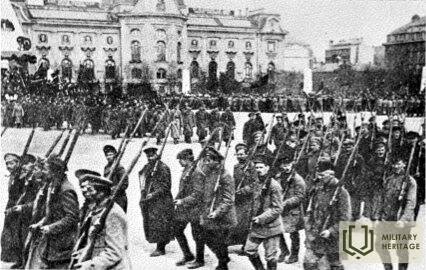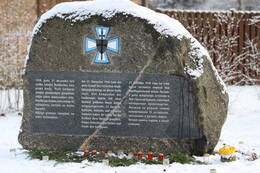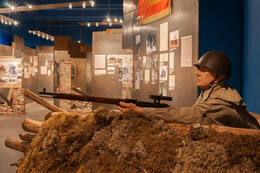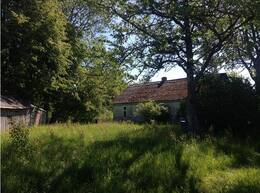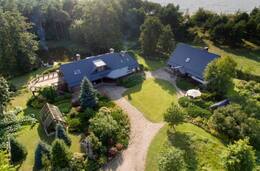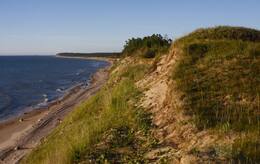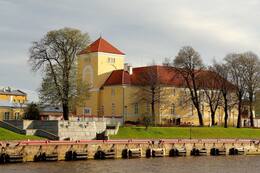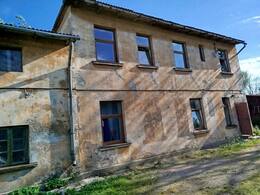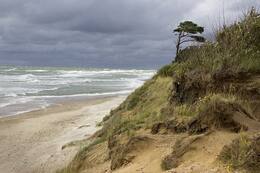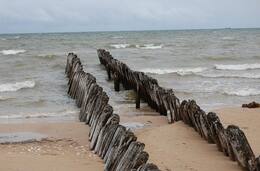Raudonoji armija užima Rygą
I Nepriklausomybės karai
1918 m. gruodžio pabaigoje Raudonoji armija artėjo prie Rygos iš šiaurės, rytų ir pietų. Iš Cėsių Rygos link žygiavo 2-asis Latvijos šaulių brigados pulkas, o abiem Dauguvos krantais – 1-oji Latvijos šaulių brigada ir Rusijos 2-asis Novgorodo šaulių divizijos pulkai. Paskutinis nesėkmingas bandymas sustabdyti Raudonąją armiją Rygos pakraštyje įvyko metų sandūroje netoli Inčukalno. Čia Landesvero kuopa kartu su Geležine brigada (taip buvo vadinami vokiečių armijos daliniai, sutikę kovoti su bolševikais) ir Rusijos antibolševikiniais daliniais per dvi mūšių dienas patyrė didelį pralaimėjimą mūšyje su 1-uoju ir 4-uoju Latvijos šaulių pulkais.
Blėstant viltims sustabdyti Raudonosios armijos ir jos „raudonųjų“ latvių šaulių artėjimą, K. Ulmanio vadovaujama Laikinoji vyriausybė, lydima Studentų kuopos, 1919 m. sausio 2 d. vidurdienį išvyko iš Rygos. Sausio 3 d. rytą miestą paliko ir likę vyriausybei ištikimi nacionaliniai kariniai daliniai – iš viso apie 400 kareivių, vadovaujamų pulkininko Oskaro Kalpako. Didžioji dalis naujai suformuotos nacionalinės armijos dezertyravo, nes nenorėjo kovoti su „raudonaisiais“ latvių šauliais. Rusų komunistų apskaičiavimai, įtraukiant Latvijos sovietinės šaulių divizijos pulkus į Baltijos šalių puolimą, buvo visiškai pagrįsti. Miestą taip pat paliko anglų karo laivai ir keli tūkstančiai pabėgėlių.
Sausio 2-osios naktį Rygoje prasidėjo ginkluotas bolševikų sukilimas. Visą naktį ir sausio 3-iąją mieste vyko chaotiški susirėmimai tarp bolševikų kovotojų, plėšikų gaujų ir mieste likusių antibolševikinių pajėgų dalinių. Miesto kalėjimų sargybiniai pabėgo, o šimtai kalinių buvo paleisti (vien iš Termincietumo kalėjimo – 600 žmonių). Susidūrimuose su Geležine brigada ir kai kuriais Landesvero daliniais netoli Rygos geležinkelio stoties, elevatoriaus ir Antrojo miesto teatro (dabar Latvijos nacionalinis teatras) žuvo 22 žmonės.
1919 m. sausio 3 d. popietę į Rygą įžengė pirmosios šaulių kavalerijos žvalgybos grupės. Popiet ir vakare į miestą įžengė iš Valkos perkeltas 6-asis Latvijos šaulių pulkas. Sausio 4 d. naktį prie sugriauto Juglos tilto traukiniu atvyko Pēterio Stučkos vadovaujama Laikinoji sovietų vyriausybė. Jos nariai persėdo į iš vokiečių atimtą šarvuotą traukinį ir naktį įžengė į Rygą. Jau trečią valandą nakties sovietų vyriausybės atstovai dalyvavo Rygos karo revoliucinio komiteto, kuris vadovavo bolševikų vadovaujamam sukilimui, posėdyje. Prasidėjo bolševikų valdymas Rygoje, trukęs mažiau nei penkis mėnesius.
Daugiau informacijos šaltinių
Sielų pūga. „Raudonieji“ šauliai įžengia į Rygą. Prieinama: https://www.dveseluputenis.lv/lv/laika-skala/notikums/106/sarkanie-strelnieki-iiet-riga/ [žiūrėta 2021-05-06].
Susijusi laiko juosta
Susijusios vietos
Paminklas pirmajam mūšiui už Latvijos nepriklausomybę
Adresas: Inčukalns, Atmodas g. 2.
2016 m. liepos 3 d. buvo atidengtas paminklas pirmajam mūšiui už Latvijos nepriklausomybę, skirtas Latvijos landesverui (Die Lettländische Landeswehr), kuriame vietos baltų vokiečiai, rusai ir latviai, tuo metu buvę abiejų pusių daliniuose, gynė naujai įkurtą valstybę nuo bolševikų Raudonosios Armijos. Brolių kapų komiteto pirmininkas Eiženas Upmanis tuo metu padarė išvadą, kad tai galėtų būti pirmasis paminklas jungtinėms Latvijos ir Baltijos vokiečių pajėgoms mūšio memorialuose už kapinių ribų. Tuo metu Latvijos landesvero latvių dalinių vadu buvo paskirtas pulkininkas leitenantas Oskaras Kalpaksas, iš kurio dalinių Laisvės kovų metu išaugo ir susiformavo vėlesnė Latvijos armija.
1918 m. visa dabartinės Latvijos teritorija pateko į Vokietijos imperijos ir jos kariuomenės rankas. Tačiau 1918 m. vasaros pabaigoje ir rudenį padėtis ėmė sparčiai keistis prieš Vokietiją ir tapo aišku, kad tik laiko klausimas, kada Vokietija bus priversta pripažinti pralaimėjimą Pirmajame pasauliniame kare. Rusijos imperija, kurios dalimi Latvija buvo iki Pirmojo pasaulinio karo, nustojo egzistuoti anksčiau, po 1917 m. vasario ir spalio revoliucijų. 1918 m. lapkričio 18 d. buvo paskelbta Latvijos Respublika. Vokietijos kariuomenė, kuri po 1918 m. lapkričio 11 d. paliaubų su Antantės valstybėmis buvo dislokuota Latvijos teritorijoje, nebebuvo motyvuota tolesniems karo veiksmams, ir dauguma jos kareivių tiesiog norėjo grįžti į tėvynę.
Tokiomis aplinkybėmis buvo akivaizdu, kad Latvijos gynyba pirmiausia priklausė nuo pačių Latvijos gyventojų suformuotos nacionalinės gvardijos. Iš pradžių, dėl savo išsilavinimo ir santykinai didesnio gebėjimo savarankiškai organizuotis, didžiausią iniciatyvą formuojant tokią nacionalinę gvardiją rodė Latvijoje gyvenantys Baltijos vokiečiai. Į nacionalinę gvardiją įstojo ir Rusijos kareiviai. Siekdama užtikrinti nacionalinės gvardijos aprūpinimą uniformomis, ginklais ir kitais reikalingais ištekliais, Latvijos laikinoji vyriausybė 1918 m. gruodžio 7 d. sudarė susitarimą su Vokietijos atstovu Augustu Vinnigu, numatantį nacionalinės gvardijos aprūpinimą iš Latvijos teritorijoje esančių Vokietijos armijos rezervų. Šiame susitarime, be kita ko, buvo nurodyta, kad ši nacionalinė gvardija, oficialiai vadinama „Latvijas zemessardze“ arba vokiškai „die Lettländische Landeswehr“, bus Latvijos Respublikos ginkluotosios pajėgos.
Latvijos nacionalinė gvardija susidūrė su dviem Latvijos raudonųjų šaulių pulkais (t. y. maždaug 2000–3000 karių), kurie anksčiau buvo patyrę Pirmajame pasauliniame kare ir Rusijos pilietiniame kare. Nepaisant Raudonosios armijos patirties ir skaitinės persvaros, Latvijos nacionalinė gvardija dvi dienas laikė Inčukalną įnirtingose kovose, kol galiausiai 1919 m. sausio 1 d. vakarą, norėdama išvengti apsupties, buvo priversta trauktis, praradusi 43 žuvusius ir kelis sužeistuosius, kurių dauguma buvo bolševikų sučiupti, kur žuvo arba mirė nuo bado ar ligų.
Autorius: Artis Buks. Medžiaga: lauko akmuo. Paminklas pagamintas iš didelio monolitinio akmens, rasto Ruļļuose netoli Jelgavos.
Latvijos karo muziejus
Latvijos karo muziejus yra įsikūręs senamiestyje, netoli Laisvės paminklo, istoriniame gynybos pastate, vadinamame „Parako bokštu“. Muziejuje yra 11 eksponatų. Čia eksponuojami įvairūs ginklai, dokumentai, uniformos, apdovanojimai, ženkleliai ir kiti daiktai, pasakojantys apie kasdienį kareivio gyvenimą kare. Latvijos karo muziejus yra vienas seniausių muziejų Latvijoje. Jo ištakos siekia Pirmąjį pasaulinį karą. Muziejaus kolekciją daugiausia sudarė asmeniniai kareivių daiktai arba mūšio laukuose rasti daiktai. Latvijai atgavus nepriklausomybę, pagrindinis muziejaus tikslas tapo sukurti ekspoziciją apie Latvijos karo istoriją ir aktyvų gyventojų vaidmenį saugant savo žemę. 1937 m. muziejus buvo išplėstas ir techniškai buvo vienas moderniausių tuo metu Europoje. Parako bokštas buvo vienas iš Rygos įtvirtinimų bokštų. Kai kurie įrodymai siekia 1330 m., kai jis buvo minimas kaip „Smėlio bokštas“. Bokštas buvo sugriautas 1621 m., kai Rygą apgulė Švedijos armija. Tačiau 1650 m. buvo pastatytas naujas bokštas parakui ir ginklams laikyti. Nugriovus miesto įtvirtinimus, Parako bokštas išlieka vienu svarbiausių Rygos gynybos sistemos įrodymų.
„Laukgalių“ namai, rašytojo Kārlio Skalbės rezidencija
Jūrkalnės valsčiaus „Laukgaliai“, vieta, kurioje rašytojas Kārlis Skalbe apsistojo 1944 m. spalio–lapkričio mėnesiais, laukdamas pabėgėlių laivo į Švediją.
Rašytojas Kārlis Skalbe (1879–1945) buvo Latvijos laikinosios nacionalinės tarybos ir Latvijos liaudies tarybos narys, Latvijos Respublikos Konstitucinio susirinkimo ir I bei IV Saeimų deputatas. Vokiečių okupacijos metais jis buvo literatūrinio žurnalo „Latvju Mēnešraksts“ vyriausiasis redaktorius, vienas iš LKP 1944 m. kovo 17 d. memorandumo signatarų.
1944 m. lapkričio 11 d. ji pabėgo į Švediją. Mirė 1945 m. Stokholme.
„Bambalių“ namai – viena iš pagrindinių laivais išplaukusių pabėgėlių apgyvendinimo vietų
Restauruoti „Bambalių“ namai Ošvalkuose, Jūrkalnės valsčiuje, kurie 1944 m. buvo viena pagrindinių valtimis išplaukusių pabėgėlių apgyvendinimo vietų Kuržemės pakrantėje.
Valčių pabėgėlio Kārlio Dravinio prisiminimai: „„Bambaliai“ buvo seni, maži, labai apgriuvę namai Jūrkalnės valsčiuje, maždaug už 40 kilometrų nuo Ventspilio. [...] Drėgnoje vietoje plytėjo nedideli laukai, bet kitoje pusėje juos apaugusi kopa apvyniojo. Už jų šiek tiek čiurlenėjo jūra – namai buvo prie pat jūros. Kitoje pusėje, už pusės kilometro, ėjo Paviluosto–Užavos plentas, bet kelias iki namų juo nebuvo lengvas, todėl vokiečiai čia negalėjo būti kasdieniai svečiai. Vieta, kur laukė valtys, buvo lengvai pasiekiama – nedidelė miško proskyna ant aukšto kranto. [...]
„Bambalių“ savininkė ir jos grupė, kurios taip pat laukė „vandens judėjimo“, gyveno dviejuose kambariuose, nukreiptuose į jūrą, o pabėgėlių grupė gyveno kitame namo gale, taip pat dviejuose kambariuose. Jie dalijosi virtuve. Koridorius tarp dviejų galų buvo prikimštas daugybės pabėgėlių daiktų. Kambariai buvo prikimšti šiaudų, kurie buvo išdėlioti palei sienas. Kiekvienoje kambario pusėje buvo po vieną lovą, kurioje miegojo motina su vaikais. Šiaudinės lovos dieną buvo užklotos paklodėmis ar kuo nors kitu. Dieną jie išeidavo jose pasėdėti ar pamiegoti, nes daugiau nebuvo kur apsistoti. [...] Dienos slinko monotoniškai, viena po kitos. Jie keldavosi pagal komandą, neskubėjo. Kai bendri pusryčiai buvo pavalgę, vieni eidavo žaisti kortomis, kiti ėmėsi būrimo, treti bandė skaityti. Vieniems reikėjo atlikti namų ruošos darbus – atnešti malkų, vandens.
Laikinosios pabėgėlių prieglaudos „Vārves būda“
„Vārves būdas“ – vieta Ventspilio savivaldybėje, kuri 1944 m. buvo laikinai apgyvendinta Latvijos pabėgėliams, laukiantiems laivų iš Gotlando.
Laivininko V. Jurjako prisiminimai:
„Mano įbrolis su šeima buvo atvykęs pas mus iš Rygos, ir kai atėjo žinia, kad Vārvėje laukiama valties, sujungiau šiuos žmones su policijos viršininko Jasūno grupe ir visi išvykome į Vārvę. Signalų laukėme iki vėlyvos nakties, bet valtis taip ir neatvyko. Taip laukėme visą savaitę. Pradėjo lyti. Žmonės iš paklodžių statė palapines, todėl šią vietą pavadinome „Vārvės trobelėmis“. Mudu su žmona dieną daugiau laiko praleisdavome Ventspilyje ir galiausiai turėjome galvoti, kaip pristatyti maistą laukiantiems. Pamenu, vieną naktį su žmona dviračiais vežėme jiems karštas virtas bulves per mišką. Smarkiai lijo, žaibavo, o šiltos bulvės labai patiko išsibarsčiusiems laukiantiems žmonėms. Vārvės miškininkas netyčia atrado šią slėptuvę, bet, pažadėjęs jam perkėlimo galimybę, atėjo padėti. Vokiečiai pradėjo žvalgytis po pakrantės gyventojų namus, ieškodami šauktinių. Du jauni žmonės buvo pagauti... miškas netoli „Vārvės trobelių“. Todėl ši vieta nebegalėjo būti saugi šiems daugiau nei penkiasdešimčiai čia merdinčių žmonių.
Kalėjimas Livonijos ordino pilyje Antrojo pasaulinio karo metu
1944–1945 metais Livonijos ordino pilyje įkurtame kalėjime buvo sulaikyti keli LKP Ventspilio ryšių grupės nariai ir pabėgėlių valčių operatoriai.
Laivininko Žanio Fonzovo prisiminimai: „Iš Švedijos išplaukė du laivai – „Krīvs“ ir „Zvejnieks“. Aš buvau „Zvejnieks“, o įguloje buvo Saulītė ir Grunti. [...] Oras buvo gražus, plaukiau taip nepastebimai, nelabai aukštai. Iškart pamačiau – plaukiau Morzės abėcėle. Laivas artėjo. Nusileidau į mašinų skyrių, nes be Saulytės dokumentų, maišelyje turėjau ir atvykusiųjų laiškus giminaičiams Latvijoje bei surinktus ginklus. Į tą ginklų maišą sumečiau laiškus ir dokumentus, o viską permečiau už borto... Kas tada! Laivas priartėjo prie mūsų, o vokiečiai paprašė mūsų vairavimo leidimų. [...] Taigi spalio 21 d. vokiečiai mus su visu „Zvejnieku“ nuvežė į Ventspilį. Nuvežė mus į kalėjimą. Kambaryje buvo apie 30 žmonių. Ant nugaros turėjau avikailio paltą, pasitiesiau jį ant grindų ir apsivilkau pats, bet praėjusią naktį nemiegojau. Antrą ar trečią dieną... Jie iškvietė mus apklausai. Buvome susitarę prisipažinti, kad esame pabėgėliai, keliaujantys į Vokietiją. Aš tik norėjau nuvykti į Lielirbę sekti savo draugo. Atrodo, kad jie tada mumis patikėjo. [...] Tačiau tada situacija Ventspilyje pasikeitė: miestą perėmė karinė administracija, ir mes buvome antrą kartą iškviesti apklausai. Buvo dar blogiau, nes mums parodė švediškų degtukų dėžutę ir kronos monetą, kurie neva buvo rasti laive. Vienas iš tardytojų buvo latvis, ir jis net nukirsdino mums galvą už tai, kad pasakėme visą tiesą. Matėme, kad pasaka baigėsi, tiesiog turėjome prisipažinti.
Pastatas Ventspilyje, kuriame 1944 m. gyveno LKP ryšininkė Valentina Jaunzeme (Lasmanė)
Name Lauku gatvėje 4, Ventspilyje, gyveno mokytoja Valentina Lasmane (mergautinė pavardė Jaunzeme) (1916–2018). Ji buvo Latvijos komunistų partijos ryšių palaikymo pareigūnė ir Ventspilio ryšių grupės narė. Po Antrojo pasaulinio karo gyveno Švedijoje.
Ji surinko 130 valtimis pabėgusių asmenų liudijimus leidinyje „Per jūrą 1944/1945“ (Stokholmas, 1990), tačiau pačios V. Lasmane gyvenimo istoriją galima perskaityti knygoje „Naktis nebe skirta tik miegui“ (Ryga, 2020). 2000 m. jai buvo įteiktas Trijų žvaigždžių ordinas. Ji mirė 2018 m., būdama 102 metų, Stokholmo priemiestyje Täbyje.
Status Staldzenės šlaitas, iš kurio 1944 m. vyko pabėgėlių laivų eismas į Švediją
1944 m. vyko aktyvus pabėgėlių laivų eismas iš Staldzenės uolų į Švedijos krantus.
Ž. Lapuķio prisiminimai apie susitikimą su dr. E. Bakusiu:
„Vieną popietę pas mane atėjo vietos policijos pareigūnas ir tyliai pasakė, kad tą naktį netoli Staldzenės kaimo, netoli Kokų kalvų, turėtų atvykti laivas iš Švedijos, kuris paimtų pabėgėlius. Mano užduotis buvo atvykti su savo dalinio sargybinių grupe saugoti šios vietos ir, jei reikės, padėti pergabenti pabėgėlius į motorlaivį. [...] Netoli jūros, nelaukdamas, priešais mus ant virvės atsistojo vyras, vilkintis pilką puspaltį su užlenkta apykakle ir žemai ant kaktos nuleistą žokėjaus kepurę. Jis tyliai pasveikino ir paklausė: „Ar tai kelias į Lošupi?“ Toks buvo švedų raitelių šūkis toje vietoje. Jis sakė, kad atvyko čia su specialia misija, bet tuo pačiu metu norėtų saugiai nugabenti savo šeimą į Švediją. Tada, mano didelei nuostabai, jis iš kišenės ištraukė mūsų miškininkystės planą. Prieblandoje pradėjau stebėti nepažįstamojo veidą ir netrukus jį atpažinau. Tai buvo Bakūzis, Miškų departamento Miškų ūkio skyriaus vedėjas [...]. Artėjo vidurnaktis, kai tolumoje jūroje pamatėme juodą tašką. Davėme sutartą signalą žibintuvėliu, kartodami jį kelis kartus. Po trumpo laiko iš juodo taško atėjo tas pats atsakymas, tik tai buvo ne žibintuvėlio, o karo laivo šviesos proveržis. Supratome, kad tą naktį valties nebelaukiama ir pabėgėlių grupė pradeda skirstytis. Bakūzis pakvietė mus abu su kuopos vadu apsistoti pas savo šeimą. Ją radome kopų įduboje po tankia egle. Ten, žaliose samanose, padėję galvas ant baltos pagalvės, giliai miegojo trys šios šeimos atžalos, o šalia... juos, apsijuosę balta skarele ant galvų, sėdėjo rūpestinga namo motina. Namo tėvas rado butelį, o namo motina pasiūlė sumuštinių. Atrodė, kad su savo latvišku nuoširdumu jie buvo tikri namo tėvas ir motina, šią lietingą rudens naktį radę savo namus po savo tėvynės egle. Vienoje pusėje šnypščia jūra, kitoje – miško masyvas ir sunkūs lietaus lašai lėtai krenta pro eglės šakas. Ištuštinome butelį, bet sumuštinių atsisakėme, nes supratome, kad jiems patiems jų labiau reikia.
Mazirbės pakrantė, iš kurios 1944 m. vyko pabėgėlių laivų eismas į Švediją
Mazirbės pakrantė buvo svarbi vieta Antrojo pasaulinio karo metu, iš kurios 1944 m. vyko pabėgėlių laivų eismas į Švediją.
Laivo pabėgėlės Ilonos Cīrulės (mergautinė pavardė Mālītis) prisiminimai: „Tuo metu man buvo 13 metų. Pamenu, kad rugsėjo pabaigoje visą savaitę keliavome nameliu ant ratų iš Rygos į Mazirbę. Kelionė mano atmintyje išliko kaip kažkas nemalonaus: danguje degančios rusiškos žvakės mane labai jaudino. Mazirbėje gyvenome apie tris savaites ir kiekvieną dieną girdėjau kalbas apie perplaukimą ir laivų paieškas. Galiausiai, spalio 21 d., turėjome ruoštis. [...] Laive buvome apie 90 žmonių. Sėdėjau tėvui ant kelių denyje. Maži vaikai su mamomis buvo apačioje, ir jiems trūko oro. Turbūt snaudžiau, bet kitos dienos rytą horizonte pastebėjau lėktuvą ir laivą. Tada žmonės nutilo. Po pietų laivas vėl atplaukė, ir šį kartą jis atplaukė tiesiai į mus. Bet tai nutiko kaip pasakoje: tai buvo Švedijos karinis laivas! Jie mus visus įtraukė į laivą, davė šiltos kakavos ir nuvežė į uostą...“ Ninėšamnas. Mūsų valtis buvo pririšta prie laivo, o jos savininkas Zariņš-Petravs ją gavo saugiai ir sveikai. Tarp svečių buvo Šici, Zanderi, Vanagi, buvusi teisingumo ministrė ponia Apsīša, mūsų šeima ir kiti. Žinau, kad už valtį reikėjo sumokėti auksu. Bet kiek – nežinau.
Susijusi istorija
Rėzeknės bombardavimas 1944 m.
Rėzeknės bombardavimas įvyko 1944 m. Velykas. Dėl to buvo sugriauta didelė dalis miesto pastatų, žuvo dešimtys civilių, o tūkstančiai liko be namų. Žmonės, kurie šiuos įvykius patyrė patys ir gali apie juos papasakoti, tuo metu buvo tik vaikai. Šios istorijos autorius yra vienas iš jų.
Gelbėtas tiltas per Negos upę nuo sprogdinimo
1944 m., vokiečiams traukiantis, buvo susprogdinta daug svarbių objektų ir to išvengti buvo labai sunku, tačiau pasakojama ir apie stebuklingus atvejus, kai vietos gyventojų drąsa ir kareivio tolerancija leido išsaugoti vietos gyventojams svarbias vietas, o lašišos išgyveno. Viena iš istorijų – apie namų šeimininkės ir vokiečių kareivio pokalbį, kuris išgelbėjo visą tiltą nuo susprogdinimo.
Pastangos užkirsti kelią Kegumo HE sprogimui
Antrojo pasaulinio karo metu, armijoms traukiantis, Latvijoje buvo susprogdinta daug kariniu ir logistiniu požiūriu svarbių objektų, kad šie ištekliai neliktų priešui. Tokie objektai buvo ir Kegumo apylinkėse, kur vienas svarbiausių objektų yra Kegumo HE, kuri, jos darbuotojų pastangų ir pastangų dėka, nebuvo visiškai sunaikinta.




